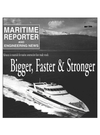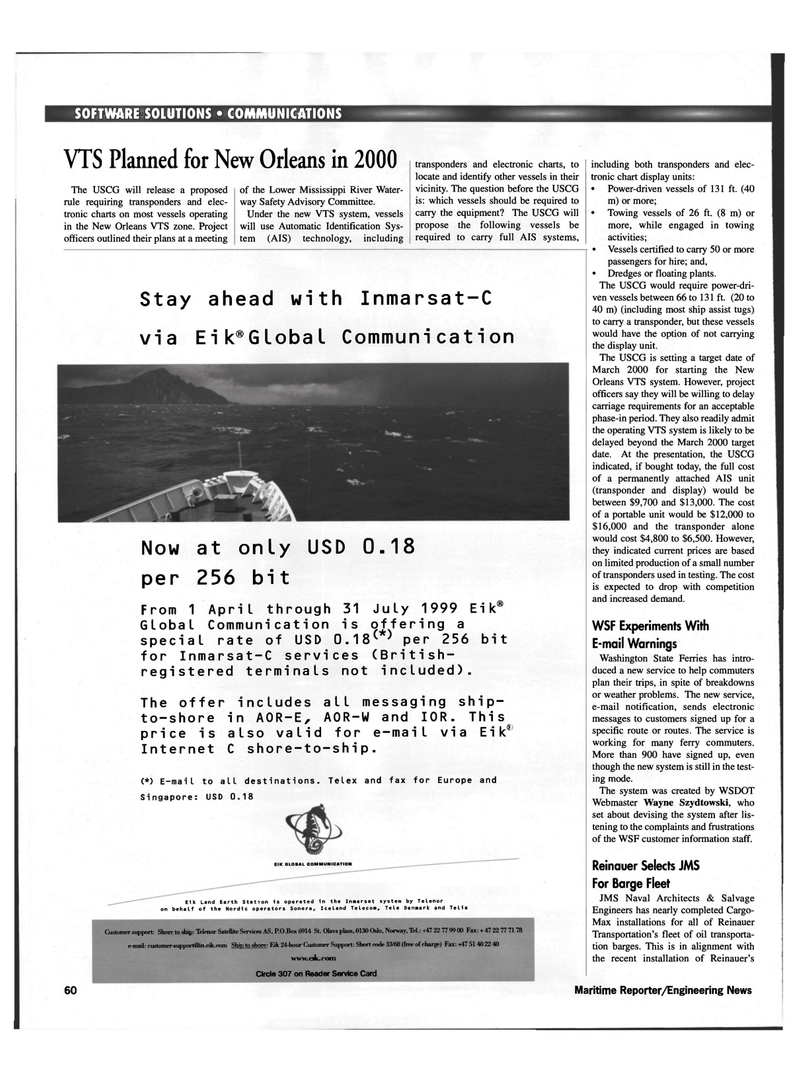
Page 60: of Maritime Reporter Magazine (May 1999)
Read this page in Pdf, Flash or Html5 edition of May 1999 Maritime Reporter Magazine
SOFTWARE SOLUTIONS • COMMUNICATIONS
VTS Planned for New Orleans in 2000
The USCG will release a proposed rule requiring transponders and elec- tronic charts on most vessels operating in the New Orleans VTS zone. Project officers outlined their plans at a meeting of the Lower Mississippi River Water- way Safety Advisory Committee.
Under the new VTS system, vessels will use Automatic Identification Sys- tem (AIS) technology, including transponders and electronic charts, to locate and identify other vessels in their vicinity. The question before the USCG is: which vessels should be required to carry the equipment? The USCG will propose the following vessels be required to carry full AIS systems, including both transponders and elec- tronic chart display units: • Power-driven vessels of 131 ft. (40 m) or more; • Towing vessels of 26 ft. (8 m) or more, while engaged in towing activities; • Vessels certified to carry 50 or more passengers for hire; and, • Dredges or floating plants.
The USCG would require power-dri- ven vessels between 66 to 131 ft. (20 to 40 m) (including most ship assist tugs) to carry a transponder, but these vessels would have the option of not carrying the display unit.
The USCG is setting a target date of
March 2000 for starting the New
Orleans VTS system. However, project officers say they will be willing to delay carriage requirements for an acceptable phase-in period. They also readily admit the operating VTS system is likely to be delayed beyond the March 2000 target date. At the presentation, the USCG indicated, if bought today, the full cost of a permanently attached AIS unit (transponder and display) would be between $9,700 and $13,000. The cost of a portable unit would be $12,000 to $16,000 and the transponder alone would cost $4,800 to $6,500. However, they indicated current prices are based on limited production of a small number of transponders used in testing. The cost is expected to drop with competition and increased demand.
WSF Experiments With
E-mail Warnings
Washington State Ferries has intro- duced a new service to help commuters plan their trips, in spite of breakdowns or weather problems. The new service, e-mail notification, sends electronic messages to customers signed up for a specific route or routes. The service is working for many ferry commuters.
More than 900 have signed up, even though the new system is still in the test- ing mode.
The system was created by WSDOT
Webmaster Wayne Szydtowski, who set about devising the system after lis- tening to the complaints and frustrations of the WSF customer information staff.
Reinauer Selects JMS
For Barge Fleet
JMS Naval Architects & Salvage
Engineers has nearly completed Cargo-
Max installations for all of Reinauer
Transportation's fleet of oil transporta- tion barges. This is in alignment with the recent installation of Reinauer's
Stay ahead with Inmarsat-C via Eik®Global Communication
Now at only USD 0.18 per 256 bit
From 1 April through 31 July 1999 Eik®
Global Communication is offering a special rate of USD 0.18( } per 256 bit for Inmarsat-C services (British- registered terminals not included).
The offer includes all messaging ship- to-shore in A0R-E, A0R-W and I0R. This price is also valid for e-mail via Eik5
Internet C shore-to-ship. (*) E-mail to all destinations. Telex and fax for Europe and
Singapore: USD 0.18
EIK GLOBAL COMMUNICATION
Eik Land Earth Station is operated in the Inmarsat system by Telenor on behalf of the Nordic operators Sonera, Iceland Telecom, Tele Danmark and Telia
Customer support: Shore to ship: Telenor Satellite Services AS, P.O.Box 6914 St. Olavs plass, 0130 Oslo, Norway, Tel.: +47 22 77 99 (X) Fax: + 47 22 77 71 78 e-mail: [email protected] Ship to shore: Eik 24-hour Customer Support: Short code 33/68 (free of charge) Fax: +47 51 40 22 40 www.esk.com
Circle 307 on Reader Service Card 60 Maritime Reporter/Engineering News

 59
59

 61
61
